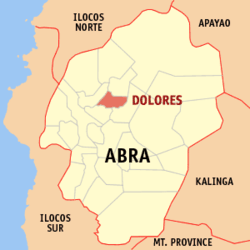Dolores, Abra
| Dolores | ||
|---|---|---|
| Municipality | ||
| ||
 Map of Abra with Dolores highlighted | ||
.svg.png) Dolores Location within the Philippines | ||
| Coordinates: 17°39′N 120°43′E / 17.65°N 120.71°ECoordinates: 17°39′N 120°43′E / 17.65°N 120.71°E | ||
| Country |
| |
| Region | Cordillera Administrative Region (CAR) | |
| Province | Abra | |
| District | Lone District of Abra | |
| Barangays | 15 (see Barangays) | |
| Government [1] | ||
| • Type | Sangguniang Bayan | |
| • Mayor | Robert Victor G. Seares Jr. | |
| • Electorate | 7,218 voters (2016) | |
| Area [2] | ||
| • Total | 47.45 km2 (18.32 sq mi) | |
| Population (2015 census)[3] | ||
| • Total | 11,315 | |
| • Density | 240/km2 (620/sq mi) | |
| Time zone | PST (UTC+8) | |
| ZIP code | 2801 | |
| PSGC | 140107000 | |
| IDD : area code | +63 (0)74 | |
| Income class | 5th municipal income class | |
| Website |
doloresonline | |
Dolores, officially the Municipality of Dolores (Ilocano: Ili ti Dolores, Filipino: Bayan ng Dolores), is a municipality in the province of Abra in the Cordillera Administrative Region (CAR) of the Philippines. The population was 11,315 at the 2015 census.[3] In the 2016 electoral roll, it had 7,218 registered voters.[4]
History
The place was called Bucao, named after the first Tingguian (Itneg) chieftain who settled in the place long before Spanish colonization. It used to be part of the Municipality of Tayum. In 1882, upon the recommendation of the parish priest of Tayum, Fr. Pío Mercado, and the Teniente Bazar of Bucao, Don Ignacio Eduarte, Bucao was created as a separate pueblo. In 1885, Bucao was renamed Dolores, to honor its patron saint, Nuestra Señora de los Dolores (Our Lady Of Sorrows). The first gobernadorcillo of the town was Don Rosalio Eduarte.
Geography
Dolores is located at 17°39′N 120°43′E / 17.65°N 120.71°E.
According to the Philippine Statistics Authority, the municipality has a land area of 47.45 square kilometres (18.32 sq mi) [2] constituting 1.14% of the 4,165.25-square-kilometre- (1,608.21 sq mi) total area of Abra.
Barangays
Dolores is politically subdivided into 15 barangays.[5]
| PSGC | Barangay | Population | ±% p.a. | |||
|---|---|---|---|---|---|---|
| 2015[3] | 2010[6] | |||||
| 140107001 | Bayaan | 4.2% | 478 | 437 | 1.72% | |
| 140107002 | Cabaroan | 4.2% | 478 | 561 | −3.00% | |
| 140107003 | Calumbaya | 4.0% | 458 | 434 | 1.03% | |
| 140107004 | Cardona | 4.9% | 553 | 463 | 3.44% | |
| 140107005 | Isit | 6.7% | 757 | 726 | 0.80% | |
| 140107006 | Kimmalaba | 7.9% | 894 | 889 | 0.11% | |
| 140107007 | Libtec | 5.9% | 665 | 638 | 0.79% | |
| 140107008 | Lub-lubba | 2.8% | 313 | 295 | 1.13% | |
| 140107009 | Mudiit | 12.9% | 1,465 | 1,439 | 0.34% | |
| 140107010 | Namit-ingan | 4.1% | 462 | 617 | −5.36% | |
| 140107011 | Pacac | 5.7% | 642 | 605 | 1.14% | |
| 140107012 | Poblacion | 19.3% | 2,185 | 2,257 | −0.62% | |
| 140107013 | Salucag | 3.5% | 397 | 551 | −6.05% | |
| 140107014 | Talogtog | 10.4% | 1,175 | 1,162 | 0.21% | |
| 140107015 | Taping | 3.5% | 393 | 425 | −1.48% | |
| Total | 11,315 | 11,499 | −0.31% | |||
Demographics
| Population census of Dolores | ||
|---|---|---|
| Year | Pop. | ±% p.a. |
| 1903 | 4,379 | — |
| 1918 | 7,061 | +3.24% |
| 1939 | 4,845 | −1.78% |
| 1948 | 4,065 | −1.93% |
| 1960 | 5,065 | +1.85% |
| 1970 | 6,751 | +2.91% |
| 1975 | 6,767 | +0.05% |
| 1980 | 7,615 | +2.39% |
| 1990 | 8,577 | +1.20% |
| 1995 | 9,560 | +2.05% |
| 2000 | 9,949 | +0.86% |
| 2007 | 10,787 | +1.12% |
| 2010 | 11,499 | +2.35% |
| 2015 | 11,315 | −0.31% |
| Source: Philippine Statistics Authority[3][6][7][8] | ||
In the 2015 census, Dolores had a population of 11,315.[3] The population density was 240 inhabitants per square kilometre (620/sq mi).
In the 2016 electoral roll, it had 7,218 registered voters.[4]
References
- ↑ "Municipality". Quezon City, Philippines: Department of the Interior and Local Government. Retrieved 31 May 2013.
- 1 2 "Province: Abra". PSGC Interactive. Quezon City, Philippines: Philippine Statistics Authority. Retrieved 12 November 2016.
- 1 2 3 4 5 Census of Population (2015). "Cordillera Administrative Region (CAR)". Total Population by Province, City, Municipality and Barangay. PSA. Retrieved 20 June 2016.
- 1 2 "2016 National and Local Elections Statistics". Commission on Elections. 2016.
- ↑ "Municipal: Dolores, Abra". PSGC Interactive. Quezon City, Philippines: Philippine Statistics Authority. Retrieved 8 January 2016.
- 1 2 Census of Population and Housing (2010). "Cordillera Administrative Region (CAR)". Total Population by Province, City, Municipality and Barangay. NSO. Retrieved 29 June 2016.
- ↑ Census of Population (1995, 2000 and 2007). "Cordillera Administrative Region (CAR)". Total Population by Province, City and Municipality. NSO. Archived from the original on 24 June 2011.
- ↑ "Province of Abra". Municipality Population Data. Local Water Utilities Administration Research Division. Retrieved 17 December 2016.
External links
| Wikimedia Commons has media related to Dolores, Abra. |
| Adjacent places of Dolores, Abra | ||||
|---|---|---|---|---|
 |
San Juan |  | ||
| La Paz | |
Lagangilang | ||
| ||||
| | ||||
| Tayum | Lagangilang | |||
